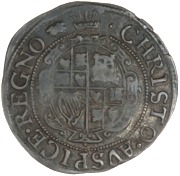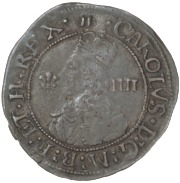 The 1638-1642 Groat - Charles I (Aberystwyth Mint)
The 1638-1642 Groat - Charles I (Aberystwyth Mint)Silver Groat of King Charles I struck between 1638 and 1642 at the Aberystwyth Mint. Diameter 23mm, weight 1.798g. SCBC 2892, North 2337, there are a number of variants.
Reverse is an oval shield with quartered arms of England, France, Scotland and Ireland. Plume at top. Legend: CHRISTO AVSPICE REGNO ("I reign under the auspices of Christ"). Mint mark is a book indicating Aberystwyth 1638-1652.
 Obverse shows a portrait of King Charles I, facing left, within an inner beaded circle. Legend is CAROLVS D G M B F ET H REX. The IIII is a mark of value (denomination of 4 pence). The plume means that the silver came from Welsh mines.
Obverse shows a portrait of King Charles I, facing left, within an inner beaded circle. Legend is CAROLVS D G M B F ET H REX. The IIII is a mark of value (denomination of 4 pence). The plume means that the silver came from Welsh mines.Image credit: Museums Victoria.
Mintage: Not known
Minted at Provincial mints
More information (monarch, year, mint, country, category) can be found below coin listings.
Below are some coins currently being offered on eBay. As an eBay Partner, We may be compensated if you make a purchase.
List items on:
List items on:
Remember 1638 ?
Monarch is King Charles I.
Charles I (1625-1649)
 Charles I was born on 19 November 1600 and was King of England, King of Scotland, and King of Ireland from 27 March 1625 until his execution on 30 January 1649. He was in the House of Stuart.
Charles I was born on 19 November 1600 and was King of England, King of Scotland, and King of Ireland from 27 March 1625 until his execution on 30 January 1649. He was in the House of Stuart.From 1642, Charles fought in the English Civil War against the armies of the English and Scottish parliaments. After his defeat in 1645, Charles refused to accept his captors' demands for a constitutional monarchy. He escaped for a few years but was recaptured by Oliver Cromwell's New Model Army. He was tried for high treason and subsequently executed.
The monarchy was abolished and the Commonwealth of England became a republic. The monarchy would be restored in 1660 by Charles's son, Charles II.
The coinage of Charles I is one of the most interesting periods of English numismatic history. There are a huge amount of varieties and the coins include both hammered and early machine-made coins by Briot. Due to the Civil war many mints popped up around the country. It's a complex and involved subject featuring some outstanding coins. It probably takes an expert to identify a coin correctly.
Category: Groat
The Groat is an old coin worth four pence. It was found in England, Ireland and Scotland. The English Groat can be traced back to Edward I and was minted (not every year) up until Victoria although the fourpence coin is still minted today for use in Maundy sets.Which Mint: Provincial mints
Not all mints are located in a single place. From the Roman days through to the middle ages it was easier to have local moneyers (trusted people who were allowed to mint coins) rather than make the coins centrally and then have the security and logistics problem of distribution.There were often dozens of mints, sometimes all making the same coin. The variations and mintmarks are exciting for numismatists, although sometimes it takes an expert to analyse them.
Most English Provincial Mints began to close after 1279 when the Royal Mint opened The Tower Mint (called so as it was housed at the Tower of London), although some continued working for much longer. The central mint gave the King and the Master of the Royal Mint much more control over the production and quality of English coinage.
Country of Origin: United Kingdom
The United Kingdom (UK) is the Union of England, Scotland, Wales and Northern Ireland. It is often refered to as Great Britain (GBR). It has a long, rich history. The orignal coinage was Pounds, Shillings and Pence but since decimalisation on 15 February 1971, it is £1 = 100p, that is One Pound = 100 pence. The coinage of the UK is also a long history, the Royal Mint being established as long ago as 886AD when coins were hammered. Today there is perhaps 30 billion coins in circulation, and many (numismatic) collectors coins and sets are issued frequently in gold, silver and other metals.








